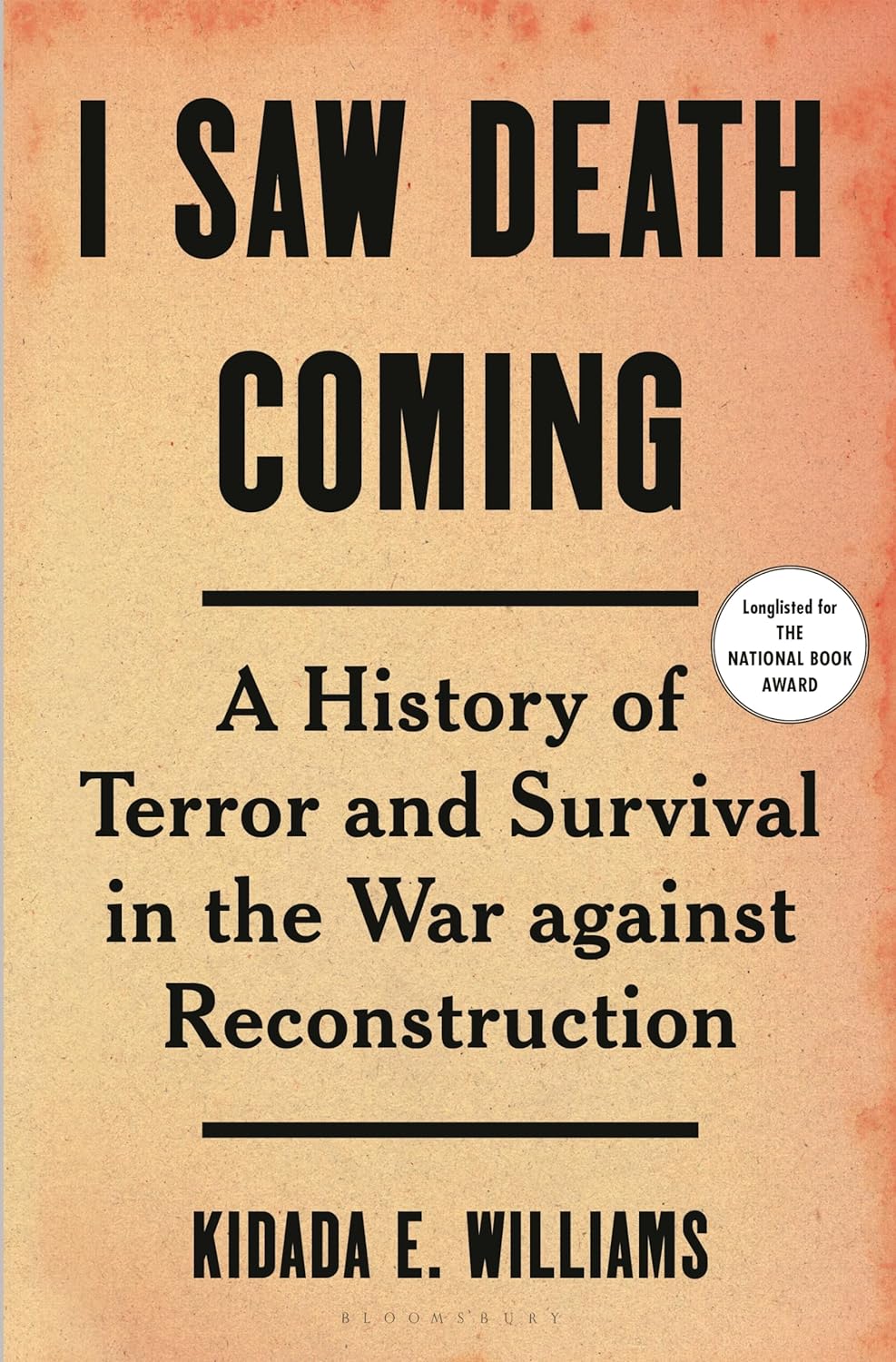Book Review: I Saw Death Coming: A History of Terror and Survival in the War against Reconstruction

 I Saw Death Coming: A History of Terror and Survival in the War against Reconstruction. By Kidada E. Williams. New York, NY: Bloomsburg Publishing, 2023. Hardcover, 384 pp., $30.00; softcover $19.99.
I Saw Death Coming: A History of Terror and Survival in the War against Reconstruction. By Kidada E. Williams. New York, NY: Bloomsburg Publishing, 2023. Hardcover, 384 pp., $30.00; softcover $19.99.
Reviewed by Tim Talbott
The sources, stories, and even novels that pushed back against a persistent, traditional “redemption” story of Reconstruction have always been around. However, many of those works that ended up published, such as Albion Tourgee’s fictional works based on his first-hand experiences, and Ted Tunnell’s brilliant Edge of the Sword: The Ordeal of Carpetbagger Marshall H. Twitchell in the Civil War and Reconstruction (2001), have largely featured white voices. Additionally, books detailing larger-scale terroristic acts in Memphis, Tennessee, and New Orleans and Colfax, Louisiana, have appeared in the last two decades. But a new wave of Reconstruction scholarship is reexamining and taking fuller stock of the wealth of information contained in the voluminous testimony provided by Black individuals and families that endured the horrors of the white overthrow of Reconstruction.
In 2021, William E. Blair delivered The Record of Murders and Outrages: Racial Violence and the Fight Over Truth at the Dawn of Reconstruction. Coming on its the heels and further opening eyes, Kidada E. Williams offers a deeper look into specific, though certainly not isolated, incidents and the long-term effects of white violence against African Americans attempting to transition from slavery to freedom, obtain land, participate in the political process, and simply pursue happiness.
As Williams points out in the book’s introduction, in 1868, describing conditions in Texas, Secretary of War Edwin M. Stanton noted that violent acts against Black people were so commonplace as to “render it impossible to keep an accurate account of them.” Stanton added that that was only possible because violence was “countenanced, or at least not discouraged by the majority of white people where it occurred.” Williams explains that these violent responses and condoning silences to Black freedom were “the pursuit of the Confederate cause by other means.” She also correctly points out that “Most white northerners and westerners had only accepted emancipation to end the war, and many weren’t any more thrilled by the prospect of legal equality than white southerners were.” (xvii)
Williams makes strong use of both the African American testimonies in the congressional report for the 1871-72 Ku Klux Klan hearings and the 1930s WPA interviews with people who had experienced slavery, the Civil War, and Reconstruction. However, she goes far beyond these initial reports in her research. She supplements them with census and court records, marriage and birth records, voting records, banking records, and deed and land purchase records, among others. Doing so helped her clearly see and then explain “how Klan [and Klan-like] attacks undid many African Americans’ achievements, families, and lives.” (xxiii)
Over the next eight chapters and a stirring conclusion, Williams provides example after horrific example of the violence enacted on the homes and bodies of African American men, women, and children in an attempt to overthrow Constitutional rights, earned in many cases by Black men who served as soldiers during the Civil War, and to maintain white supremacy at all costs in all things social, political, and economic. Williams explains that it is important that we learn about these events and “We must explore the violence they detailed because the forces driving it persist.” (xxv)
White supremacy terrorists understood the significance of attacking the African American family, and if possible in their homes, when all members were present. The home is understood to be a sanctuary, and Williams calls the Black home “the very center of freedom.” (74) Surprise assaults on families shattered notions of one’s ability to protect oneself and their loved ones. The killings, physical beatings, and sexual assaults inflicted in an effort to intimidate Black people from enjoying their liberties were devastating enough. But Williams takes the discussion further and also shares important considerations by examining the psychological effects that such night-riding attacks had on African Americans. As Williams explains, science shows that fight or flight responses triggered by assaults at unexpected times “undermines the ability to think and act rationally. If this causes the victim to behave bizarrely or unpredictably, it can make them even more vulnerable to harm.” (77)
Of course, psychological damage from terror events could also have long-term effects, particularly if those had come along after the heavy oppression of years or decades of slavery and then the tumult of living through the Civil War. “Moral injuries from being attacked could damage victims’ psyches. Raids could hollow victims out, imperiling a person’s capacity for joy, compromising their ability to love, undermining their talents,” Williams explains. (137) All of these soul-devastating outcomes were, of course, the intent of the terrorists, who wished to keep Black people in continued subservience.
Wonderfully researched, extremely thought-provoking, and well-written, I Saw Death Coming certainly adds to our fuller understanding of Reconstruction and helps us consider points previously much less clear. It is sure to maintain an important place in Reconstruction historiography.
I met and talked with Kidada Williams, and heard her book talk, at the History Book Festival in Lewes, Delaware in September 2023. I mentioned the research I’ve done for my biography of George Boutwell (WW Norton, January 2025), who chaired the Senate Committee investigating the outrages of the 1875 Mississippi Plan, producing a report of 2,000 pages detailing similar violence and intimidation carried out by white Democrats to “redeem” their state during the 1875 county and state election. There’s no lack of documentation on how such violence was the key to the ultimate success of the “Lost Cause” in reversing the outcome of the Civil War.
I appreciate reading and learning more about the topic of reconstruction.